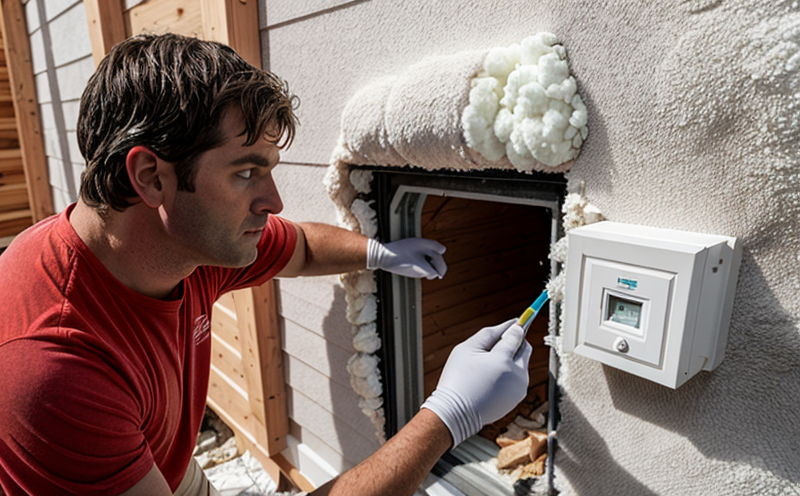ASTM C518 Heat Flow Meter Thermal Testing
The ASTM C518 heat flow meter thermal testing method is widely used to determine the thermal conductivity of rigid materials, particularly those employed in building and infrastructure applications. This test provides critical insights into the insulation properties of materials like polystyrene foam, polyurethane foams, and other similar insulating products.
The ASTM C518 Heat Flow Meter method is based on the steady-state heat flow through a flat sample. The apparatus consists of two plates that sandwich the test specimen, with one plate being heated to a specified temperature while the other remains at a lower temperature. A calorimeter measures the rate of heat transfer between these plates.
Understanding thermal conductivity is essential for architects and engineers in selecting appropriate insulation materials for buildings and infrastructure projects. This test ensures that the selected materials meet the required performance standards, thereby enhancing energy efficiency and reducing heating and cooling costs.
The testing process involves precise specimen preparation to ensure accurate results. Specimens must be cut into uniform rectangular shapes with a known area and thickness. The sample is then conditioned in an environment at 23°C ± 1°C for 16 hours prior to the test to minimize any moisture content variations that could affect the thermal conductivity readings.
The ASTM C518 method is reliable due to its standardized procedure, which ensures consistent results across different laboratories. The apparatus used includes a heat flow meter calorimeter with two plates and an electronic circuit for measuring temperature and power consumption. The test setup allows for the accurate measurement of the steady-state heat flow through the sample.
The accuracy of this method is further enhanced by the use of reference materials such as calibrated plates or standard samples whose thermal conductivity values are known. These references help calibrate the apparatus and ensure that the results are within acceptable tolerances.
ASTM C518 testing is particularly important in sectors like building & infrastructure where energy efficiency is a key concern. By ensuring that insulation materials meet the required thermal performance standards, this test contributes to sustainable construction practices and helps reduce environmental impact.
| Parameter | Description |
|---|---|
| Test Sample Preparation | Cutting into uniform rectangular shapes with known area and thickness; conditioning in a 23°C ± 1°C environment for 16 hours. |
| Heating Plate Temperature Range | Typically between 50°C to 90°C, depending on the material being tested. |
| Cooling Plate Temperature Range | Typically between -20°C to 10°C. |
| Calibration Reference Materials | Standard samples with known thermal conductivity values used for calibration of the apparatus. |
The ASTM C518 heat flow meter thermal testing method is a cornerstone in the quality assurance process for insulation materials. It provides precise and reliable data that are essential for compliance with building codes and standards, as well as for ensuring product performance in real-world applications.
Scope and Methodology
- Cutting of test samples into uniform rectangular shapes with known area and thickness.
- Conditioning the samples in a 23°C ± 1°C environment for 16 hours prior to testing.
- Heating one plate to a specified temperature range (50°C to 90°C) while cooling the other plate within another specified range (-20°C to 10°C).
- Maintaining steady-state heat flow through the sample and measuring it using a calorimeter.
- Calibrating the apparatus with reference materials of known thermal conductivity values.
The ASTM C518 test method is designed to evaluate the thermal conductivity of rigid insulating materials under controlled conditions. The results provide valuable data for quality assurance, compliance checking, and performance optimization in building & infrastructure applications.
Why Choose This Test
- Precision: ASTM C518 ensures consistent and accurate measurement of thermal conductivity.
- Standardization: The method is based on international standards (ASTM C518), ensuring comparability across different laboratories.
- Sustainability: By selecting materials that meet the required insulation performance, this test contributes to energy-efficient buildings and infrastructure projects.
- Compliance: It helps in meeting building codes and regulatory requirements for thermal insulation.
- Performance Optimization: The accurate data provided by ASTM C518 aids in optimizing material selection for specific applications.
The ASTM C518 heat flow meter thermal testing method is an essential tool for quality managers, compliance officers, R&D engineers, and procurement professionals. Its reliability and precision make it a preferred choice for ensuring that insulation materials meet the highest performance standards.
Customer Impact and Satisfaction
The ASTM C518 heat flow meter thermal testing method has a direct impact on customer satisfaction in several ways:
- Enhanced Product Quality: By ensuring that insulation materials meet the required performance standards, this test enhances product quality.
- Cost Efficiency: Selecting appropriate insulation materials with accurate thermal conductivity data can lead to significant cost savings through improved energy efficiency.
- Sustainability: The method supports sustainable construction practices by minimizing environmental impact.
- Regulatory Compliance: Meeting building codes and regulatory requirements enhances customer confidence in the products used in their projects.
- Performance Optimization: Accurate data provided by ASTM C518 helps in optimizing material selection for specific applications, leading to better performance outcomes.
In summary, the ASTM C518 heat flow meter thermal testing method is a vital tool that ensures product quality, enhances customer satisfaction, and supports sustainable practices in building & infrastructure projects.





